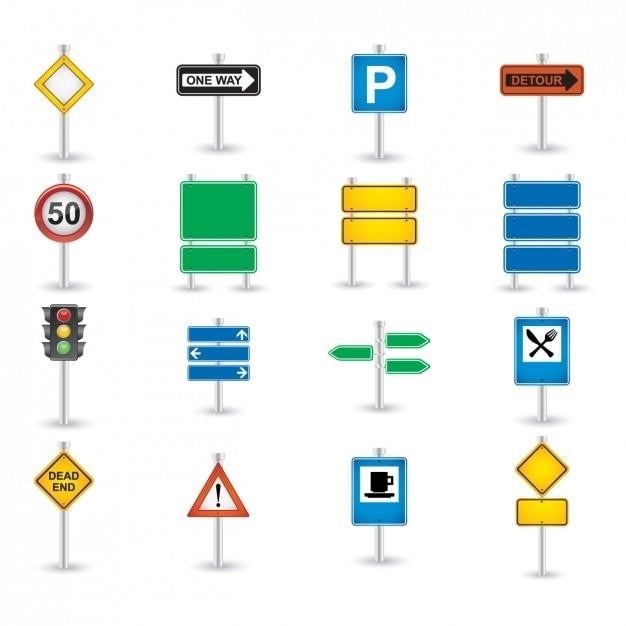señales manuales de transito
Manual Traffic Signals
Manual traffic signals‚ often referred to as hand signals‚ are a vital form of communication used by drivers and pedestrians to convey their intentions and ensure safe navigation on the road‚ particularly in situations where standard vehicle signals are malfunctioning or unavailable. These signals provide a visual indication of a driver’s upcoming actions‚ helping to prevent accidents and maintain order on the road.
Importance of Manual Traffic Signals
Manual traffic signals‚ also known as hand signals‚ play a crucial role in road safety and efficient traffic flow. They serve as a backup communication system when standard vehicle signals fail or are unavailable‚ ensuring drivers and pedestrians can understand each other’s intentions and navigate safely. In situations where vehicle signals are malfunctioning‚ hand signals become indispensable for indicating turns‚ stops‚ or warnings‚ preventing accidents and maintaining order on the road.
Moreover‚ hand signals are particularly important in emergencies‚ such as when a vehicle’s electrical system is compromised or when a driver needs to communicate with pedestrians or other vehicles in situations where verbal communication is impractical. Their use is especially vital in areas with limited visibility or where traffic flow is heavy‚ allowing drivers to signal their intentions clearly and promptly‚ reducing the risk of collisions or misunderstandings.
Furthermore‚ hand signals contribute to a more comprehensive understanding of road safety by reinforcing the importance of clear communication between road users. They encourage drivers to be more attentive to their surroundings and to anticipate the actions of other road users‚ promoting a culture of safe driving and responsible road behavior. By providing a visual language for drivers‚ hand signals contribute to a safer and more organized road environment.
Types of Manual Traffic Signals
Manual traffic signals‚ or hand signals‚ are categorized based on the specific action they communicate. These signals are typically used when a vehicle’s turn signals are malfunctioning or unavailable‚ allowing drivers to convey their intentions clearly and effectively to other road users.
One of the most common types of manual signals is the “left turn signal.” This signal is executed by extending the left arm straight out the window‚ with the hand pointing in the direction of the intended turn. Similarly‚ the “right turn signal” involves extending the right arm straight out the window‚ with the hand pointing in the direction of the turn.
Another crucial signal is the “stop signal‚” which is used to indicate the driver’s intention to stop. This signal involves extending the left arm straight out the window‚ with the palm facing outward and the fingers pointing down. This signal is particularly important in situations where a vehicle needs to stop suddenly‚ alerting other road users to the impending stop.
The “slow down signal‚” also known as the “reduce speed signal‚” is executed by extending the left arm straight out the window with the palm facing downward and moving the hand in a downward motion. This signal indicates to other road users that the driver is slowing down and needs to be cautious.
Standard International Manual Signals
While the general concept of manual traffic signals is widely understood‚ there are internationally recognized standards for these signals to ensure consistency and clarity across different regions. These standards are crucial for promoting safe and efficient traffic flow‚ especially when drivers from different countries share the road.
The Geneva Convention of 1909 established a set of standardized hand signals‚ laying the foundation for international recognition. This convention introduced four basic signals⁚ turning‚ crossing‚ cassís (a warning signal for obstacles)‚ and level crossing. Since then‚ the number of signals has expanded significantly‚ with the Vienna Convention on Road Signs and Signals‚ adopted in 1968‚ further refining and expanding the standards.
The most commonly recognized international signals include the left and right turn signals‚ executed by extending the left or right arm straight out the window‚ with the hand pointing in the direction of the intended turn. The stop signal‚ involving extending the left arm straight out the window with the palm facing outward and the fingers pointing down‚ is also widely accepted. Other standardized signals include the slow down signal‚ the hazard signal‚ and the warning signal for oncoming traffic.
These international standards help ensure that drivers from different countries can understand each other’s intentions when using hand signals‚ contributing to safer and more efficient road travel.
Manual Signals for Turning
Manual signals for turning are essential for communicating a driver’s intentions to other road users‚ particularly when conventional turn signals are not functioning or are not visible in certain situations. These signals provide a clear visual indication of the driver’s upcoming maneuver‚ enabling other drivers and pedestrians to anticipate and react accordingly‚ enhancing safety on the road.

To signal a left turn‚ the driver extends their left arm straight out the window‚ with the hand pointing in the direction of the turn. This signal is universally recognized and understood by drivers and pedestrians alike‚ allowing for effective communication on the road. Similarly‚ to signal a right turn‚ the driver extends their right arm straight out the window‚ with the hand pointing in the direction of the turn. This simple but effective signal ensures clear communication of the driver’s intended maneuver.
The consistency of these signals across different regions and countries is crucial‚ as it facilitates smooth and safe interactions between drivers from diverse backgrounds. Using standard hand signals for turning ensures clear communication and reduces the risk of misunderstandings or misinterpretations‚ ultimately contributing to a safer driving environment for all.
Manual Signals for Warning
Manual signals for warning are crucial for alerting other road users to potential hazards or unexpected situations that require immediate attention or action. These signals serve as a visual communication tool‚ conveying critical information to drivers and pedestrians‚ ensuring their safety and preventing accidents. They are particularly important when a vehicle’s warning lights are malfunctioning or when the driver needs to communicate a warning beyond the capabilities of their vehicle’s signaling system.
One common warning signal involves extending the driver’s left arm straight out the window and moving it back and forth in a sweeping motion. This signal indicates to following vehicles that there is an obstacle ahead‚ requiring them to slow down or adjust their driving path. Another common warning signal involves extending the driver’s right arm straight out the window and pointing it downwards. This signal indicates to following vehicles that the driver intends to slow down or stop abruptly‚ prompting them to prepare for a sudden change in speed.
These warning signals are essential for maintaining safe driving practices‚ especially in situations where verbal communication is impossible or inadequate. By utilizing these signals‚ drivers can effectively communicate potential hazards to other road users‚ reducing the risk of accidents and ensuring a safer driving environment for all.
Manual Signals for Stopping
Manual signals for stopping are an essential part of safe driving‚ particularly when a vehicle’s brake lights are malfunctioning or when the driver needs to communicate their intention to stop in a clear and unambiguous way. These signals provide a visual cue to other road users‚ allowing them to anticipate the driver’s actions and adjust their own driving accordingly‚ thus preventing potential accidents. They are particularly important in situations where a sudden stop is necessary‚ such as when encountering a pedestrian or an unexpected obstacle.
The standard manual signal for stopping involves extending the driver’s left arm straight out the window and pointing it downwards. This signal‚ also known as the “stop” signal‚ is universally recognized and clearly indicates to other road users that the driver intends to come to a complete stop. This signal is particularly important in situations where the driver needs to communicate their intent to stop in a timely manner‚ ensuring that other road users have enough time to react and avoid a collision.
By utilizing this signal‚ drivers can effectively communicate their intention to stop to other road users‚ ensuring a safer driving environment for all. It is important to note that‚ while using manual signals for stopping can be helpful‚ drivers should always strive to maintain their vehicle’s brake lights in good working order to ensure safe and predictable driving practices.
Use of Manual Signals in Emergencies
Manual traffic signals play a crucial role in emergency situations‚ enabling drivers and pedestrians to communicate effectively and ensure the safety of all involved. When vehicles experience mechanical failure or encounter hazardous situations‚ such as a flat tire or a stalled engine‚ manual signals become an essential tool for conveying vital information to other road users. By utilizing these signals‚ drivers can alert others to their predicament‚ allowing them to take necessary precautions and avoid potential collisions.
In emergency situations‚ drivers should utilize standard manual signals to indicate their intention to stop or pull over to the side of the road. This allows other drivers to anticipate their actions and adjust their driving accordingly‚ preventing potential accidents. For instance‚ a driver experiencing a flat tire might utilize the “stop” signal‚ extending their left arm straight out the window and pointing it downwards‚ indicating their intent to stop safely on the shoulder of the road.
Manual signals can also be used to warn other road users of potential hazards. If a driver encounters an obstruction or a dangerous condition‚ such as a downed power line or a fallen tree‚ they can use manual signals to alert other drivers to the danger‚ allowing them to take evasive action and avoid potential accidents. These signals serve as a crucial communication tool in emergency situations‚ ensuring the safety of all road users.

Legal Recognition of Manual Signals
While traffic laws primarily focus on standardized traffic signals and signage‚ manual signals are often acknowledged and even explicitly mentioned in traffic regulations across many jurisdictions. This recognition stems from the practical need for effective communication in situations where standard signals are unavailable or malfunctioning‚ ensuring road safety and order. While the specific legal framework may vary‚ most jurisdictions recognize the importance of manual signals in emergency situations‚ particularly when vehicle lights are not functioning properly.
Traffic laws typically stipulate that drivers must utilize manual signals when their vehicle’s turn signals are inoperable. This legal recognition underscores the importance of effective communication between drivers and other road users‚ even when standard signals are not available. It highlights the legal obligation for drivers to use manual signals as a viable alternative for safe and predictable maneuvering on the road. This legal framework helps to ensure that drivers can communicate their intentions effectively‚ minimizing the risk of accidents and promoting a safer driving environment.
The legal recognition of manual signals reflects a pragmatic approach to road safety‚ acknowledging the need for alternative communication methods in situations where standard signals are not functioning. By incorporating manual signals into traffic regulations‚ jurisdictions strive to ensure that drivers can communicate their intentions effectively‚ contributing to a safer and more predictable driving environment. This legal framework underscores the importance of manual signals as a vital communication tool for drivers‚ particularly in situations where standard signals are not available.
Safety Benefits of Using Manual Signals
Manual traffic signals‚ or hand signals‚ offer a range of safety benefits‚ especially in scenarios where standard vehicle signals are malfunctioning or unavailable. These benefits stem from their ability to clearly communicate a driver’s intentions to other road users‚ minimizing confusion and potential accidents. The use of manual signals plays a crucial role in ensuring safety and order on the road by providing a visual means of communication that can be easily understood by other drivers and pedestrians.
One of the primary safety benefits of manual signals is their ability to enhance visibility‚ especially in challenging conditions such as poor lighting or heavy traffic. When a driver’s turn signals are not functioning‚ manual signals serve as a visible alternative‚ clearly indicating their intentions to other road users. This increased visibility helps to prevent collisions and ensures that drivers can anticipate each other’s movements‚ promoting a safer driving environment.
Moreover‚ manual signals can be particularly helpful in situations where drivers may be hesitant to use their horn or other auditory signals. They offer a more discreet way to communicate intentions‚ especially in situations where excessive noise could create confusion or alarm other road users. This ability to communicate clearly and effectively‚ without creating unnecessary disturbances‚ helps to maintain a sense of order and reduces the risk of accidents. Overall‚ manual signals offer a simple yet effective way to ensure safe and efficient communication on the road‚ promoting a safer driving environment for all.


